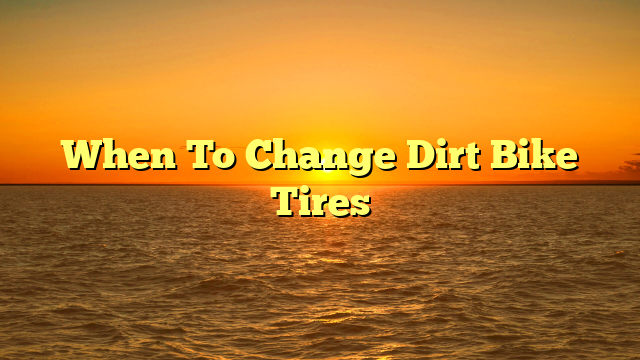Bike tires are an essential part of any cycling experience, and their condition can influence the rider’s safety and performance.
Understanding how often to replace bike tires is crucial for any cyclist to ensure they are riding on safe and functional equipment.
This article will provide an in-depth guide on the lifespan of bike tires, the factors that affect their wear and tear, and the signs that indicate they need to be replaced.
Firstly, we will discuss the different types of bike tires, as this can significantly impact the frequency of replacement.
There are various types of tires, including road, mountain, hybrid, and touring, each with different tread patterns and sizes.
In addition, some tires are made of different materials, such as rubber, kevlar, or carbon fiber, which can affect their longevity.
Understanding the differences between these tire types can help cyclists make informed decisions about their replacement schedule.
Table of Contents
- 1 Key Takeaways
- 2 Understanding the Lifespan of Bike Tires
- 3 Different Types of Bike Tires
- 4 Factors that Affect the Wear and Tear of Bike Tires
- 5 Signs that Your Bike Tires Need Replacing
- 6 How to Choose the Right Replacement Tires
- 7 Proper Maintenance to Extend the Life of Your Tires
- 8 Tips for Riding Safely on Worn Tires
- 9 Frequently Asked Questions
- 9.1 Can you repair a punctured bike tire or is replacement always necessary?
- 9.2 How do I know if my bike tires are wearing out prematurely?
- 9.3 Do different types of bike tires have different lifespans?
- 9.4 Can I mix and match different types of bike tires on my bike?
- 9.5 How much should I expect to spend on a new set of bike tires?
- 10 Conclusion
Key Takeaways
- The lifespan of bike tires is impacted by quality, use frequency, and terrain.
- Signs of worn-out tires include visible cracks, uneven wear patterns, and decreased traction and stability.
- Punctures prevention is important to prolong tire life.
- Selecting the right replacement tires is crucial for performance and safety.
Understanding the Lifespan of Bike Tires
The lifespan of bike tires is determined by a variety of factors, including the quality of the tire, the frequency and intensity of use, and the terrain on which the bike is ridden.
Assessing wear is an important aspect of determining when to replace bike tires.
This process involves examining the tire for signs of cracking, tearing, or baldness.
If the tire shows significant signs of wear, such as visible cords or threads, it is time to replace the tire.
Another factor that impacts the lifespan of bike tires is tire pressure management.
Underinflated tires can cause excessive wear and tear, while overinflated tires can lead to blowouts.
It is important to regularly check and maintain proper tire pressure according to the manufacturer’s recommendations.
Additionally, riders should monitor their tire pressure during rides and adjust as necessary to ensure optimal performance and longevity of their tires.
By understanding these factors and taking appropriate measures, riders can extend the lifespan of their bike tires and enjoy a safe and smooth ride.
Different Types of Bike Tires
Various categories of bicycle tires exist, each designed to cater to specific cycling needs.
Road bike tires, for instance, are engineered for high-speed riding on smooth surfaces, whereas mountain bike tires are designed for off-road riding on rough trails.
Hybrid bike tires, on the other hand, are a combination of both road and mountain bike tires, making them suitable for a variety of terrains.
Within each category of bike tires, there are additional subcategories, such as tubeless and tubular.
Tubeless tires are becoming increasingly popular due to their ability to reduce punctures and offer a smoother ride.
They are designed to be used without an inner tube, which means that the tire is filled with sealant, sealing any punctures that may occur while riding.
Tubular tires, on the other hand, are glued to the rim and are commonly used in professional road racing.
They are lightweight, offer a smoother ride, and have a higher level of grip compared to traditional clincher tires.
When it comes to choosing the right tread, road bike tires typically have a slick or semi-slick tread pattern, whereas mountain bike tires have a knobby tread pattern for better traction on rough terrain.
Ultimately, selecting the right type of bike tire depends on the type of cycling you’ll be doing and the conditions you’ll be riding in.
Factors that Affect the Wear and Tear of Bike Tires
Factors that impact the longevity of bicycle tires include the type of terrain, the frequency of use, and the tire’s composition.
Tire pressure is another important factor that can affect the wear and tear of bike tires.
If the tire pressure is not maintained properly, it can lead to premature wear of the tire.
Low tire pressure can cause the tire to wear out faster, while high tire pressure can cause the tire to wear out unevenly.
Therefore, it is important to check the tire pressure regularly and maintain it at the recommended level.
Riding conditions also play a significant role in the wear and tear of bike tires.
Riding on rough or uneven terrain can cause the tires to wear out faster than riding on smooth surfaces.
Wet or muddy conditions can also cause the tires to wear out faster, as the tires have less traction and are more likely to slip.
Additionally, frequent hard braking or cornering can cause the tires to wear out faster.
To extend the life of bike tires, it is recommended to ride on smooth surfaces, avoid riding in wet or muddy conditions, and practice smooth braking and cornering techniques.
Signs that Your Bike Tires Need Replacing
Indications of worn-out bicycle tires can be observed through visible cracks, uneven wear patterns, and a decrease in traction and stability while riding.
Visible cracks on the tire’s sidewall or tread are signs of wear and tear.
These cracks can lead to punctures, which can be dangerous, especially when riding at high speeds.
Uneven wear patterns are also an indication that the tires need replacing.
This usually occurs when the tires are not inflated to the recommended pressure or when the tires are not rotated regularly.
When the tires are not inflated to the recommended pressure, the tread wears out faster in some areas.
It is important to check the tire pressure regularly and adjust it accordingly to prevent uneven wear and tear.
Another sign that your bike tires need replacing is a decrease in traction and stability while riding.
This is particularly noticeable when riding on wet or slippery surfaces.
Old tires lose their grip and become slick, making it difficult to control the bike.
Punctures prevention is also an important factor in determining when to replace bike tires.
If the tire has punctures that cannot be repaired, it is time to replace the tire.
It is important to check the tire for punctures regularly, especially after riding on rough terrain.
In conclusion, it is important to keep an eye out for visible cracks, uneven wear patterns, and a decrease in traction and stability while riding to determine when to replace bike tires.
Regular tire pressure adjustments and puncture prevention measures can help prolong the life of your bike tires.
How to Choose the Right Replacement Tires
Selecting the appropriate replacement tires is crucial for enhancing your bike’s performance, ensuring safety, and improving your overall riding experience.
When choosing replacement tires, it is essential to consider the type of riding you do, the terrain you typically ride on, and the size of your current tires.
Here are some factors to consider when selecting the right replacement tires for your bike:
- Brand recommendations: Research different brands and read reviews to find a reputable and reliable tire manufacturer.
Some of the top brands in the market include Continental, Schwalbe, Maxxis, and Michelin.
- Tire size options: Make sure to choose tires that fit your bike’s rims and are compatible with your bike’s frame.
Check the sidewall of your current tires to find the size information, which usually includes the width, diameter, and recommended pressure range.
- Tread pattern: The tread pattern affects your bike’s grip, traction, and durability.
Choose a tread pattern that suits your riding style and terrain, whether you need a more aggressive tread for off-road trails or a smoother tread for smoother roads.
- Tire construction: The tire’s construction affects its weight, durability, and puncture resistance.
Choose a tire with a high TPI (threads per inch) count for a smoother ride and better puncture protection.
By considering these factors, you can find the right replacement tires for your bike that offer improved performance and safety.
Make sure to consult with a bike mechanic or experienced rider if you have any doubts or questions about the tire selection.
Proper Maintenance to Extend the Life of Your Tires
Proper maintenance is crucial for maximizing the lifespan of your bicycle’s tires and ensuring optimal performance.
One of the most important aspects of tire maintenance is maintaining the correct tire pressure.
Proper tire pressure can greatly affect the handling and stability of your bike, as well as its overall efficiency.
It is recommended that you check your tire pressure before each ride, as changes in temperature and riding conditions can cause fluctuations in pressure.
The recommended tire pressure can usually be found on the sidewall of your tire, and it is important to ensure that your tires are not underinflated or overinflated.
Another important aspect of tire maintenance is proper cleaning techniques.
Dirt, debris, and other foreign objects can cause damage to your tires over time, so it is important to keep them clean.
To clean your tires, use mild soap and water and a soft-bristled brush.
Avoid using harsh chemicals or abrasive cleaning tools, as these can cause damage to the tire’s surface.
Additionally, be sure to dry your tires thoroughly after cleaning to prevent any moisture from causing damage.
By properly maintaining your tires through regular cleaning and checking tire pressure, you can help to extend their lifespan and ensure optimal performance.
Tips for Riding Safely on Worn Tires
When tires become worn, it is important to adjust your riding style and be more cautious to ensure safety while riding.
Riding on worn tires can be dangerous as the tread depth decreases, leading to less grip on the road.
Here are some tips for riding safely on worn tires:
- Use smooth and controlled movements when steering, accelerating, and braking.
Abrupt changes in direction or speed can cause the tires to lose traction.
- When turning, lean the bike gradually and avoid sudden movements that can cause the tires to slip.
- When braking, apply the brakes evenly and avoid sudden stops that can cause the tires to skid.
- Be prepared for emergency handling situations.
Worn tires may not provide as much grip in emergency situations, so it is important to be aware of your surroundings and anticipate potential hazards.
- Keep a safe distance from other vehicles and be prepared to react quickly if necessary.
- Practice emergency braking and swerving maneuvers in a safe and controlled environment to improve your skills and confidence in handling unexpected situations.
By following these riding techniques and being more cautious on worn tires, you can help ensure a safer and more enjoyable riding experience.
Remember to monitor your tires regularly and replace them when necessary to maintain optimal safety and performance.
Frequently Asked Questions
Can you repair a punctured bike tire or is replacement always necessary?
When faced with a puncture in a bike tire, the decision to patch or replace depends on various factors.
DIY repairs can be cost-effective, but may not provide a long-term solution.
Professional repairs offer a more reliable outcome but are often more expensive.
The pros and cons of each option should be weighed before making a decision.
How do I know if my bike tires are wearing out prematurely?
Determining premature tire wear on a bike can be done by inspecting the tread depth, checking for cracks or cuts, and monitoring inflation levels.
Causes of premature wear can include over or under-inflation, rough terrain or poor maintenance.
Tips for extending tire lifespan include maintaining proper inflation, avoiding sharp objects, and rotating tires regularly.
Do different types of bike tires have different lifespans?
Tire durability factors vary among different types of bike tires and can affect their lifespan.
Proper tire maintenance, such as keeping them inflated to the recommended pressure and avoiding harsh surfaces, can also prolong their use.
Can I mix and match different types of bike tires on my bike?
Mixing tires on a bike can raise compatibility concerns due to performance differences and traction comparisons.
It is advisable to use identical tires to ensure consistent handling and performance.
Mixing different types of tires may lead to unpredictable behavior and affect riding safety.
How much should I expect to spend on a new set of bike tires?
When comparing prices for new bike tires, it is important to consider reputable brands such as Continental, Michelin, and Schwalbe.
Prices can range from $20 to $100+ per tire depending on factors such as tire type and size.
Conclusion
In conclusion, bike tires are an essential component of your bike that requires attention and upkeep.
Understanding the lifespan of your tires, as well as the factors that affect their wear and tear, can help you determine when it’s time to replace them.
Signs such as cracks, bulges, or worn-out trends indicate that it’s time to invest in new tires.
Choosing the right replacement tires depends on the type of bike you have and the type of riding you do.
Proper maintenance such as checking tire pressure regularly and avoiding harsh terrain can extend the life of your bike tires.
However, it’s crucial to keep in mind that worn-out tires can compromise your safety.
Riding on worn-out tires can increase the risk of accidents, especially in wet or slippery conditions.
Therefore, it’s essential to replace your bike tires as soon as you notice any signs of wear and tear.
With these tips in mind, you can enjoy a safe and comfortable ride on your bike.







